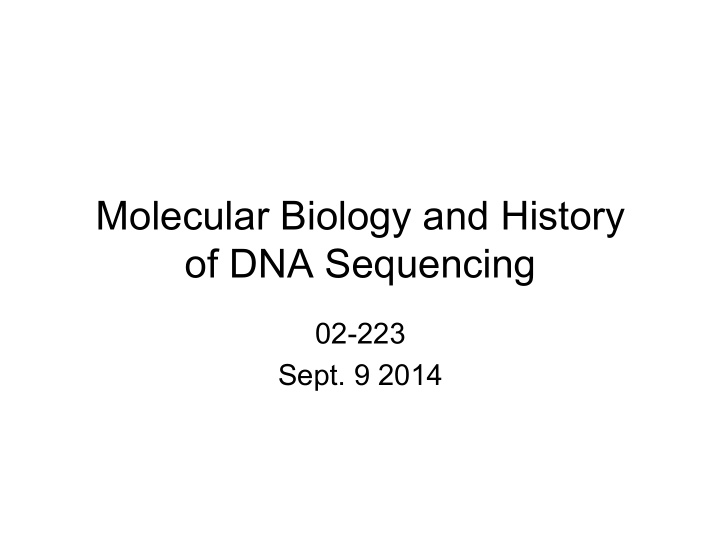



Molecular Biology and History of DNA Sequencing 02-223 Sept. 9 2014
History of DNA Thomas Morgan first James Watson and described Francis Crick proposed Gregor Mendel first linkage and that DNA is a double described patterns of recombination strand with a double inheritance helical structure 1866 1869 1911 1950 1953 Fredrich Edwin Chargaff Miescher first discovered that A and isolated DNA T, and G and C have equal amounts
http://www.nature.com/scitable/content/dna-is-a-double-helix-24263
History of DNA Frederick Sanger Arthur Kornberg Hamilton Smith developed dideoxy replicated DNA in- Commercial discovered DNA DNA sequencing ~100 vitro using DNA automated DNA restriction bases/reaction polymerase synthesizer enzymes ~1000 bases/ PCR developed reaction by Kary Mullis 1957 1961 1970 1971 1977 1983 1986 1996 First genome sequenced using Leroy Hood Marshall in-vitro replication by Ray Wu, developed Nirenberg A.D. Kaiser, and Ellen Taylor . automated elucidated the Phage λ , ~5000 nt took over 3 sequencing codons years
DNA Polymerase
h"p://www.virology.ws/2009/05/10/the-‑error-‑prone-‑ways-‑of-‑rna-‑synthesis/ ¡
Even ¡with ¡proofreading, ¡mistakes ¡made ¡ every ¡10 7 -‑10 9 ¡bases ¡ 6 ¡billion ¡bases ¡in ¡human ¡genome! ¡ h"p://www.virology.ws/2009/05/10/the-‑error-‑prone-‑ways-‑of-‑rna-‑synthesis/ ¡
Molecular Biology of the Cell. 4th edition. Alberts B, Johnson A, Lewis J, et al. New York: Garland Science; 2002.
PCR • Polymerase ¡Chain ¡ReacJon ¡ • Invented ¡in ¡1983 ¡ • DNA ¡polymerase ¡from ¡ Thermus ¡aqua+cus ¡ • 2.2x10 5 ¡error ¡rate ¡
Polymerase Chain Reaction (PCR) overview buffer, ssDNA primers, dNTPs, 5’ 3’ + DNA sample DNA polymerase ( Taq ) 3’ 5’ Mg 2+ - enzyme cofactor Separate DNA strands ~94 o C Melt: 30 sec 5’ 3’ 3’ 5’ Tm - 5 o C 30 sec Anneal: 5’ 3’ 3’ 5’ Hybridize ssDNA primers 5’ 3’ 72 o C Extend: 30 sec/kb Extend from primers 3’ 5’ Melt 25-35 x Anneal cycles Extend
Let’s perform paper PCR
Polymerase Chain Reaction (PCR) overview Starting DNA Final DNA http://www.accessexcellence.org/RC/VL/GG/ polymerase.php
Polymerase Chain Reaction (PCR) overview http://www.accessexcellence.org/RC/VL/GG/ polymerase.php
http://www.lifetechnologies.com/us/en/home/life-science/ pcr/elevate-pcr-research/pcr-video-library/pcr- animation.html
PCR over time h"p://mtbakerbio.com/sites/default/files/images/RTPCR%20graphSml.gif ¡
Sanger Sequencing
Following growing DNA strand with ddNTPs All 4 dNTPs added to each. 10% of the following ddNTP added as well ddATP ddGTP ddTTP ddCTP At any base that complements the ddNTP, 10% chance of terminating
Paper sequencing Now that we have all these strands of DNA whose final base we know, what do we do with them?
Gel Electrophoresis
ATGGACCAGTTG ATGGACCAGTT ATGGACCAGT ATGGACCAG ATGGACCA ATGGACC ATGGAC ATGGA ATGG ATG AT A
A=green G=yellow T=red C=blue
HGP and Celera ABI ¡3730x ¡ (Sanger) ¡
Pros and Cons of SS • Polymerase errors • Can only do 1 average out sequence at a time • Long sequences • Need a lot of DNA to (~450 bp) start with • Expensive: 2¢/base
Questions?
Recommend
More recommend